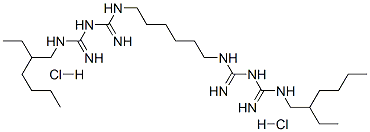1715-30-6
 1715-30-6 結(jié)構(gòu)式
1715-30-6 結(jié)構(gòu)式
基本信息
WIN-21904
Bisguadine
Sterwin 904
Compound-904
Bisguanidine
1,1'-Hexamethylenebis[5-(2-ethylhex-1-yl)]biguanide dihydrochloride
N,N''-Bis(2-ethylhexyl)-3,12-diiMino-2,4,11,13-tetraazatetradecanediiMidaMide
N,N''-bis(2-ethylhexyl)-3,12-diimino-2,4,11,13-tetraazatetradecanediamidine dihydrochloride
N,N''-Bis(2-ethylhexyl)-3,12-diimino-2,4,11,13-tetraazatetradecanediimidamidedihydrochloride
安全數(shù)據(jù)
| 報(bào)價(jià)日期 | 產(chǎn)品編號(hào) | 產(chǎn)品名稱 | CAS號(hào) | 包裝 | 價(jià)格 |
| 2024/11/08 | A3389 | 阿來(lái)西定二鹽酸鹽 Alexidine Dihydrochloride | 1715-30-6 | 25MG | 125元 |
| 2024/11/08 | A3389 | 阿來(lái)西定二鹽酸鹽 Alexidine Dihydrochloride | 1715-30-6 | 100MG | 490元 |
常見(jiàn)問(wèn)題列表
PTPMT1
Alexidine dihydrochloride displays activity against most
Candida
spp.; MIC values of ≤1.5?μg/mL are observed for all isolates tested under planktonic conditions, with the exception of
Candida parapsilosis
and
Candida krusei
. Interestingly, Alexidine dihydrochloride also displays striking activity against clinically relevant fluconazole-resistant
Candida
isolates:
C. albicans
(CA2, CA6, and CA10),
C. glabrata
(CG2 and CG5),
C. parapsilosis
(CP5), and
C. auris
(CAU-09 and CAU-03).
Inhibition of planktonic growth by Alexidine dihydrochloride reveals a complete inhibition of filamentation or proliferation of the imaged fungi. Alexidine dihydrochloride is able to decimate at low concentrations (1.5 to 6?μg/mL) mature biofilms of
Candida
,
Cryptococcus
, and
Aspergillus spp
. that are known to be resistant to almost all classes of antifungal drugs. In fact, at 10-fold-lower concentrations (150?ng/mL) of planktonic MICs, Alexidine dihydrochloride could inhibit lateral yeast formation and biofilm dispersal in
C. albicans
.
Alexidine dihydrochloride results in 50% killing of HUVECs and lung epithelial cells, at concentrations 5- to 10-fold higher than the MIC required to kill planktonically growing fungal pathogens.
Chosen to focus on biofilm formation by C. albicans , since a murine biofilm model has been well established in this fungus and used for testing the effects of established and new antifungal agents. The effect of the drugs on the 24-h-old biofilms growing in the jugular vein catheters of mice is visualized microscopically, which reveals significantly lower density of the biofilms in catheters treated with Alexidine dihydrochloride. In fact, fungal CFU determination reveals that Alexidine dihydrochloride inhibits 67% of fungal biofilm growth and viability, compared to the control untreated biofilms.
